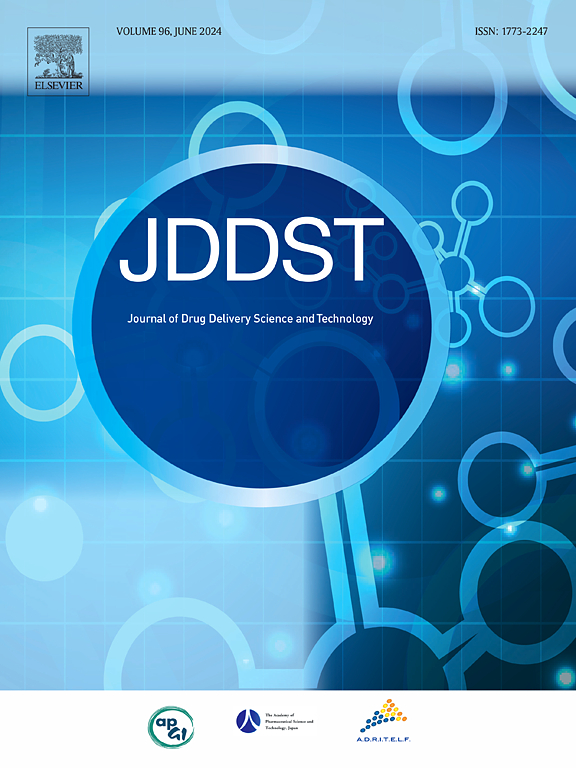Implementation of design of experiments in liposome manufacturing: ethanol injection and extrusion as a case study
IF 4.9
3区 医学
Q1 PHARMACOLOGY & PHARMACY
Journal of Drug Delivery Science and Technology
Pub Date : 2025-07-01
DOI:10.1016/j.jddst.2025.107236
引用次数: 0
Abstract
Although substantial advancements in microfluidics and continuous manufacturing have been made, particularly for lipid nanoparticles (LNPs) used in nucleic acid delivery, conventional liposomes for small-molecule drugs pose distinct challenges. These formulations are typically manufactured via ethanol injection followed by extrusion, a two-step process unlike the integrated nature of microfluidics. This separation introduces additional complexity, as individual unit operations may influence each other, making early-stage optimization more difficult and often requiring iterative refinement across the process. Scaling up these conventional methods remains a challenge, especially in achieving reproducibility, scalability, and regulatory compliance.
Design of Experiments (DoE) provides a valuable framework for understanding and optimizing such processes. However, in the early development stages, particularly in industry, its use is often limited by high material costs, time-consuming analyses, and the need for timely decision-making. Moreover, the existing literature rarely offers detailed, practical guidance tailored to formulation scientists working under these constraints.
This study presents an objective, step-by-step application of DoE to early-phase liposomal formulation development at the 100 mL scale. The goal is not to build highly predictive models, but to rapidly identify robust, workable conditions that enable progression to later development stages. This pragmatic approach reflects the interdependence of manufacturing steps, where downstream processes, such as tangential flow filtration and remote drug loading, may influence or negate prior optimizations.
By evaluating key parameters like ethanol content, stirring speed, and extrusion conditions, the study offers a practical roadmap for resource-conscious process development, supporting informed decision-making in real-world industrial settings.

脂质体生产实验设计的实施:以乙醇注射和挤出为例
尽管在微流体和连续制造方面取得了实质性进展,特别是用于核酸递送的脂质纳米颗粒(LNPs),但用于小分子药物的传统脂质体面临着明显的挑战。这些配方通常是通过乙醇注射然后挤压制造的,这是一个两步过程,不像微流体的集成性质。这种分离引入了额外的复杂性,因为单个单元操作可能会相互影响,使得早期阶段的优化更加困难,并且通常需要在整个过程中进行迭代改进。扩展这些传统方法仍然是一个挑战,特别是在实现可再现性、可伸缩性和法规遵从性方面。实验设计(DoE)为理解和优化这些过程提供了一个有价值的框架。然而,在早期开发阶段,特别是在工业中,它的使用往往受到高材料成本、耗时分析和需要及时决策的限制。此外,现有文献很少为在这些约束下工作的配方科学家提供详细的、实用的指导。本研究提出了一个客观的,一步一步的应用DoE在100毫升规模的早期脂质体制剂开发。目标不是建立高度预测的模型,而是快速识别健壮的、可行的条件,使其能够进展到后期的开发阶段。这种实用的方法反映了生产步骤的相互依赖性,其中下游工艺,如切向流过滤和远程药物装载,可能会影响或否定先前的优化。通过评估乙醇含量、搅拌速度和挤压条件等关键参数,该研究为具有资源意识的工艺开发提供了实用的路线图,为现实工业环境中的明智决策提供了支持。
本文章由计算机程序翻译,如有差异,请以英文原文为准。
求助全文
约1分钟内获得全文
求助全文
来源期刊
CiteScore
8.00
自引率
8.00%
发文量
879
审稿时长
94 days
期刊介绍:
The Journal of Drug Delivery Science and Technology is an international journal devoted to drug delivery and pharmaceutical technology. The journal covers all innovative aspects of all pharmaceutical dosage forms and the most advanced research on controlled release, bioavailability and drug absorption, nanomedicines, gene delivery, tissue engineering, etc. Hot topics, related to manufacturing processes and quality control, are also welcomed.

 求助内容:
求助内容: 应助结果提醒方式:
应助结果提醒方式:


